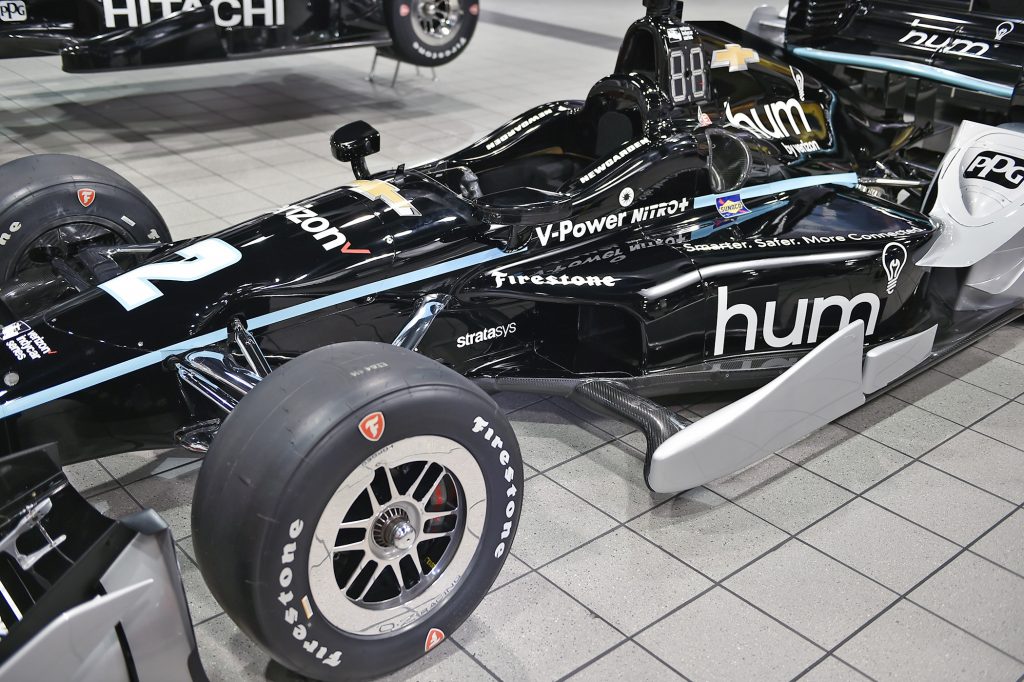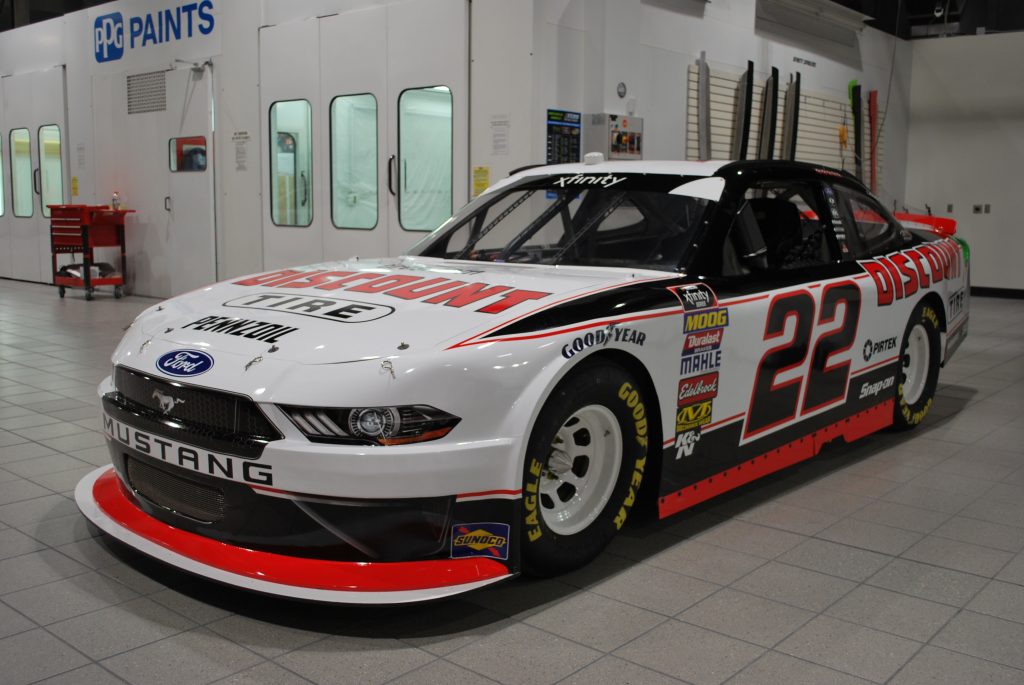What happened in 3D printing at RAPID & TCT 2019?
DSM and CEAD to develop new materials and applications for pelletized 3D printing
First look at the new Stratasys V650 SLA 3D printer from AMUG 2019
Leading industry stakeholders to develop roadmap for 3D printing in lighting, building, and construction
Royal DSM and JuggerBot 3D launch trial program to aid adoption of 3D printing
3D printing news Sliced: 3D Systems, Optomec, Luxexcel, Local Motors
DSM and FormFutura ink 3D printer filament distribution deal
Stratasys Releases Dedicated Chopped Carbon Fiber Polyamide 3D Printer Fortus 380mc Carbon Fiber Edition

Stratasys/Team Penske Copyright: Scott R LePage
Stratasys today is launching a 3D printer specifically intended for carbon-fiber-filled Nylon 12. The Fortus 380mc Carbon Fiber Edition which we wrote about before will cost $70,000 in the US and is on sale now. Stratasys has offered carbon fiber 3D printing for a number of years now but only on systems priced above $200,000.
Stratasys Senior Vice President of Sales, Pat Carey says of the move,
“They’ve told us they want an affordable solution but in a reliable, industrial-quality system. So we’re now offering a more accessible system that’s based on our Fortus 380mc platform. Because the 380mc CFE is dedicated only to carbon-fiber-filled Nylon 12 and one other material, we’re able to currently offer it at the lowest price for any of our industrial printers.”
Stratasys describes the applications of the material as
“Stratasys expects the quickest adopters of its Fortus 380 CFE 3D Printer to be those making tooling and fixtures and those in industries that include Automotive; Recreational Sporting Equipment; Marine; Orthosis and Prosthesis; Defense; Aerospace; Medical Equipment; Oil and Gas.Similar to a typical injection molded carbon fiber reinforced plastic part, Stratasys Nylon 12CF is 35 percent chopped carbon fiber by weight, and it exhibits the highest stiffness-to-weight ratio of any FDM or FFF 3D printed part.”
“Stratasys Nylon 12CF is up to four times stronger than a competitively priced alternative in the X and Y axis, and it will maintain its mechanical properties at a 40 percent higher temperature. The Fortus 380mc CFE is between two and five times faster than the competitively priced carbon-fiber-based 3D printer.”
“Parts don’t exhibit appreciable warpage or shrinkage and will hold to
a tight tolerance. ““The Fortus 380 CFE builds parts in 0.010 in. (0.254 mm) layer thickness. The system is also compatible with ASA thermoplastic, for which is can build in either 0.010 or .005 in. (0.127 mm) layer thicknesses. The 3D printer’s build chamber measures 14 x 12 x 12 in. (355 x 305 x 305 mm). It offers water-soluble support material removal, which eliminates the need for manual labor to remove the supports.

Terry Wohlers of Wohlers Associates says,
“For many years, the additive manufacturing industry has seen a need for a diversity of
machines that produce parts in high-strength composite materials, I’m hopeful the newest
machine from Stratasys will help to meet this need by offering strong parts in carbon fiber
and Nylon 12.”
IndyCar and NASCAR Examples
Team Penske, an IndyCar and NASCAR team makes prototypes and end-use parts from carbon-fiber-filled Nylon 12. Lightweight mirrors were made of the material and used in racing. Lightweight 3D printed mirrors is actually a tried and true application that has been tested and used across many racing series. It is also sometimes a bit of a crib since race teams feel comfortable talking about mirrors and their associated geometries. Meanwhile, they usually use the technology for other parts of the car that they are less open about discussing especially the more angelic teams. Racing itself is an exciting area, especially one for showcasing your products. It is also the gateway drug to the automotive industry. Upon reading the press release this was the first thought that came to mind along with, is this the Innovator’s Dilemma again as well as MarkForged must sure be doing well.

Stratasys/Team Penske
Monday 18 December 2017
Copyright: Scott R LePage
MarkForged
MarkForged has a continuous composite 3D printer that should produce strong parts but may tend to be more limited in design freedom. The company has pitched to the car industry from the beginning and is finding clients, growth and customers there. With Porsche on board as an investor, the erstwhile small company’s growth is vexing perhaps to Stratasys. Perhaps the firm is trying to toy with MarkForged’s inertia until its own High-Speed Sintering technology is ready for automotive? Stratasys is also a Desktop Metal investor and that company has sued MarkForged over patents related to metal printing, which MarkForged is also engaged with. Although this would be a tempting conclusion I think that there is much bigger game afoot.
Innovator’s Dilemma
Invented FDM as a technology and commercialized it, this is now used by over 500 or so startups worldwide clamoring for market share and growth. In the long run rather than one venture-backed firm I think that this hardscrabble open ecosystem is what could be a competitive threat to Stratasys. To place obstacles in between oneself’s profit centers and the oncoming hordes seems like a wise decision. The release of the competitively prices 123 systems from Stratasys and below this, the Makerbot printers are a testimony to this. Essentially I believe that Stratasys is trying to delay the competition by at several hereto noncontested price points place interesting propositions for companies willing to industrialize 3D printing for manufacturing. Bizarrely a few years ago there were barely any functional parts capable 3D printers between the price point of $2000 and $5000 and none between $20,000 and $100,000. So Stratasys is filling out its product line up in order to motivate companies to partner with it now for the long run. This is a crucial time in 3D printing because many firms are certifying parts, qualifying parts and going into production for the first time. There is also the Troop of Gorillas. These soft and gentle giants munch on leaf after leaf and just want to make the world a better place through plastics.
Polyamide
Polyamide is a huge market and a material that is used in many industrial applications. The Troop of Gorillas consists of a dozen or so chemicals and polymer companies each doing billions in revenue. A few of these, namely, Evonik, Arkema, DSM, Dow, BASF and Sabic have a lot of polyamide capacity and are active in investing in polyamide high-performance materials. These materials are subject to higher heat deflection, continuous service temperature and strength than existing materials. They also let these companies sell a reformulated version of existing capacity at an elevated price point. These companies would be more than happy to invest in significant revenue for the long term for their materials. PPA’s or high-performance polyamides will be a battleground in many applications in the years to come, a big win in volume for 3D printed automotive would be huge for each of these firms. Indeed, I still believe that BASF’s high interest in 3D printing stems mainly for it to be a source of next-generation PPA’s. So what application and industry will give us the biggest volumes the soonest?

Automotive
Impact, wear, stiffness and overall familiarity that components manufacturers have with the Polyamide (Nylon 12) material is driving adoption of this material in automotive. It has been used for a long time in prototyping and for small production runs. The material has been used in bridge manufacturing by companies such as CRP and the automotive companies have considerable expertise in it. Especially the divergent parts of the Volkswagen group and BWM. PPA’s are high performance enough to be used inside the engine bays, inside the cabin on exterior parts and throughout the supply chain in tooling, jigs, and fixtures. They’re more expensive than bulk and engineering plastics but often cheaper than ultra high-performance materials such as PEEK and PEI. They’re also far easier to use than those materials. So a new high-performance niche which is usable at volume is emerging. And the players in this niche have a fundamental choice between partnering up now to industrialize for the next decades. Its a game of musical chairs.

Fortus 380CF
Musical Chairs
And in the musical chairs game, there is a choice between the future performance of open systems and the current performance of Stratasys systems. Closed Stratasys systems that do not permit you to use any outside materials are more reliable with higher repeatability at this point. Open systems have lower reliability but much lower costs. This machine introduction, therefore, seems aimed squarely at introducing 3D printing in manufacturing for automotive. This is a system that universities can afford so that they can do research on these carbon fiber materials. This system an alternative to high-temperature printers that are emerging around the same price point for PEEK and PEI. These systems will be cheaper to buy but the part cost will be higher than with carbon fiber filled polyamide. Stratasys is, therefore, positioning this as an alternative to MarkForged, high-temperature systems, existing powder bed fusion systems and the promise of open systems in the future. You know us, you trust us, here is something that you can buy today. Vis a vis powder bed fusion FDM has a clear advantage in large singular parts and flat parts while SLS may be better for many thousands of small parts (this is geometry and size dependent). I think that this is a smart move to position this now for production at a lower price point with more acceptible part costs for automotive. In the coming year or two, the game of musical chairs in automotive will be played with partners for materials and production found. And once the music stops, the game will be over.
